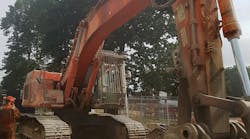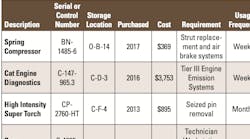Human intelligence and experience combine with today’s tools for diagnosing, testing, maintaining, and repairing machines and heavy trucks to create a powerful, effective force for reducing downtime and economically extending the useful life of equipment assets. This report presents a selection of such tools, along with thoughts about machine maintenance from people who are involved in keeping equipment up and running on a day-to-day basis. Some of the tools most shops can afford; others tools, more sophisticated, require careful thought about economics and utilization before making the investment.
Diagnostic Tools
DPF Maintenance
As more machines with Tier 4-Interim engines are placed into service, more equipment owners are learning what most heavy-duty truck owners already know—that the diesel particulate filter (DPF) used on many of these machines must be periodically removed and cleaned.
Although the DPF is designed to burn away the soot (unburned hydrocarbons) that it collects, some particulate substances in the exhaust stream don’t burn and eventually collect in the fine honeycombed substrate (structure) of the filter.
“The DPF does not burn off mineral compounds left over from lubricant-additive packages, fuel-additive packages, and minute particles from engine wear,” says Drew Taylor, a principal in FSX Equipment, a firm that designs and manufacturers DPF-cleaning equipment. “The debris stacks up in a predictable way and occupies space intended for soot. If the ash goes too long without cleaning, the thermal dynamics of the DPF begin to change.”
As ash builds up and increases restriction, the DPF system will initiate more frequent active regeneration (soot-burning) cycles, and the added heat might cause filter failure. The substrate is very brittle, says Taylor, and might begin to crack where the hotter open areas of the substrate cells meet cooler areas insulated by the ash. Because these areas do not expand at the same rate, cracking can result.
Another potential problem of neglected ash build-up is glazing or sintering, which occurs if potassium in the ash causes glass-like formations in the substrate—resulting in diminished soot-filtering capability.
To prevent damaging the DPF, cleaning should be performed at least by the interval recommended by the machine/truck manufacturer. Some equipment owners, however, are opting to clean more frequently, not only to protect the DPF, but also to ensure that fuel economy does not potentially decline as ash causes increased backpressure. (Whether ash buildup diminishes fuel economy is an issue of some debate in the industry.)
In the cleaning process, the DPF typically is initially tested to determine its degree of restriction and then cleaned pneumatically. If pneumatic cleaning does not return the filter to acceptable specifications (usually 95 percent of its new airflow rating), it can be thermally cleaned via a high-temperature process that burns away collected ash over a period of six hours or so.
Although some equipment manufacturers have DPF exchange programs, in which equipment owners receive a cleaned DPF in exchange for the DPF removed from their machines, some owners, especially those with good maintenance practices, are opting to keep their original DPF and pay to have it cleaned—usually around $300 for the pneumatic cleaning and another $100 to $200 for thermal cleaning.
The Mighty Laptop
“Going back 10 years or so,” says Steve Deller, product support manager for West Side Tractor Sales, a John Deere dealer in suburban Chicago, “the primary reason for having a laptop in the service department was to run the OEM’s diagnostic software. Present day, the laptop has much more functionality.”
Having the OEM’s proprietary diagnostic software at each shop or field technician’s fingertips via the laptop is still a primary application for this valuable tool, says Deller. But today, he says, the laptop’s ability to deliver software updates to onboard machine controllers is also an essential function, along with setting calibration values for various electronic components.
In addition, says Deller, the laptop connects technicians to the manufacturer’s database of historical trouble-shooting information and allows technicians to engage a manufacturer’s technical-assistance engineers for more help. The laptop also places the manufacturer’s manuals in one convenient location and permits technicians to order parts electronically.
“Another benefit of the laptop is the ability it gives to the technician to access diagnostic information remotely through the machine’s telematics system,” says Deller. “But beyond all of the connectivity and machine information the laptop provides, it also connects our technicians directly into our business systems, where they can clock in and out of work orders, input technical write ups, and manage their work-order schedules.”
According to Rich Hoffmeyer, product support manager for McCann Industries, a Case dealer with locations in the Chicago area, the dealership has grown in its use of laptops from one mandatory package to run the manufacturer’s diagnostics software—shared by all the locations and perhaps used once every six weeks—to having laptops in all the shops and nearly all the field-service trucks—all in daily use.
Kokosing Construction’s Ed Englert gives this advice to service departments contemplating laptop purchases: “Look for models with the most battery life and memory capacity that fit the budget.”
Maintaining Hydraulic Systems
Diego Navarro, John Deere global fleet management solutions manager, says that it takes two approaches to fine filtration in oil-based systems.
“Portable filter caddies are used to purify liquids after repairs,” says Navarro, “and permanently installed ‘micronic filters’ also are used to polish fluids to extreme levels. These onboard filters are installed in a by-pass mode, that is, they take a small stream of fluid and clean it slowly, removing very small particles and humidity.”
Fluid cleanliness, especially in a high-pressure hydraulic system, is of paramount importance for system reliability and longevity. As Navarro noted, portable filtration equipment, supplemented with particle counting, can be extremely useful in maintaining mobile hydraulic systems, whether a crawler dozer’s implement system or a skid-steer loader’s hydrostatic propel system.
“We use the Deere Super Caddy [portable filtration system] to clean hydraulic systems, transfer fluids, and certify fluids to certain cleanliness levels,” says Steve Deller, West Side Tractor, “and onboard sensors provide particle count and percentage of water saturation. The system can be used with a fluid-sampling program to extend fluid life, and it’s also used post-failure to ensure that when a component is replaced, the system is clean and contaminant-free.”
Stand-alone particle-counting devices also are available, such as the Spectrex PC-2300 In-Situ Particle Counter, which is designed to permit thorough inspection of liquids without consuming the sample. According to the manufacturer, the instrument’s laser beam permits observation of small particles by “near-forward light scatter,” and, in addition, a scanning and detection system is provided to automatically quantify the number of small particles in one milliliter of the contained fluid.
“A particle counter can be expensive,” says Kokosing’s Ed Englert, “but it’s a wise choice if the budget allows. But, then again, regarding the budget, a particle counter is still less expensive than a hydraulic pump and related components.”




